Selected Approaches to the Assessment of Environmental Noise from Railways in Urban Areas
Abstract
1. Introduction
2. Materials and Methods
2.1. Measurement Locations
2.2. Measurement Methodology and Prediction Methods
3. Results
4. Discussion
4.1. Discussion of Results
4.2. Comparison of Results with Another Research
5. Conclusions
Author Contributions
Funding
Institutional Review Board Statement
Informed Consent Statement
Data Availability Statement
Acknowledgments
Conflicts of Interest
References
- Rojas-Rueda, D.; Morales-Zamora, E.; Alsufyani, W.A.; Herbst, C.; AlBalawi, S.M.; Alsukait, R.; Alomran, M. Environmental Risk Factors and Health: An Umbrella Review of Meta-Analyses. Int. J. Environ. Res. Public Health 2021, 18, 704. [Google Scholar] [CrossRef]
- Hahad, O.; Beutel, M.E.; Gilan, D.A.; Micha, M.; Daiber, A.; Munzel, T. Impact of environmental risk factors such as noise and air pollution on mental health: What do we know? Deut. Med. Wocenschr. 2020, 145, 1701–1707. [Google Scholar] [CrossRef]
- Kases, C.; Maly, T.; Majdak, P.; Waubke, H. The relation between psychoacoustical factors and annoyance under different noise reduction conditions for railway noise. J. Acoustical Soc. Am. 2017, 141, 3151–3163. [Google Scholar] [CrossRef]
- Seidler, A.; Wagner, M.; Schubert, M.; Droge, P.; Romer, K.; Pons-Kuhnemann, J.; Swart, E.; Zeeb, H.; Hegewald, J. Aircraft, road and railway traffic noise as risk factors for heart failure and hypertensive heart disease—A case-control study based on secondary data. Int. J. Hyg. Environ. Health 2016, 219, 749–758. [Google Scholar] [CrossRef] [PubMed]
- Wothge, J.; Niemann, H. Adverse health effects due to environmental noise exposure in urban areas. Bundesgesundheitsblatt Gesundh. Gesundh. 2020, 63, 987–996. [Google Scholar] [CrossRef] [PubMed]
- Van Kamp, I.; Simon, S.; Notley, H.; Baliatsas, C.; Van Kempen, E. Evidence Relating to Environmental Noise Exposure and Annoyance, Sleep Disturbance, Cardio-Vascular and Metabolic Health Outcomes in the Context of IGCB (N): A Scoping Review of New Evidence. Int. J. Environ. Res. Public Health 2020, 17, 3016. [Google Scholar] [CrossRef] [PubMed]
- Halperin, D. Environmental noise and sleep disturbances: A threat to health? Sleep Sci. 2014, 7, 209–212. [Google Scholar] [CrossRef] [PubMed]
- Roosli, M. Health effects of environmental noise exposure. Ther. Umsch. 2013, 70, 720–724. [Google Scholar] [CrossRef] [PubMed]
- Wosniacki, G.G.; Zannin, P.H.T. Framework to manage railway noise exposure in Brazil based on field measurements and strategic noise mapping at the local level. Sci. Total Environ. 2021, 757, 143721. [Google Scholar] [CrossRef]
- Němec, M.; Danihelová, A.; Gergeľ, T.; Gejdoš, M.; Ondrejka, V.; Danihelová, Z. Measurement and Prediction of Railway Noise Case Study from Slovakia. Int. J. Environ. Res. Public Health 2020, 17, 3616. [Google Scholar] [CrossRef] [PubMed]
- Pathak, S.S.; Lokhande, S.K.; Kokate, P.A.; Bodhe, G.L. Assessment and Prediction of Environmental Noise Generated by Road Traffic in Nagpur City, India. In Environmental Pollution, Proceedings of 5th International Conference on Water, Environment, Energy and Society (WEES), AISECT Univ, Bhopal, India, 15–18 March 2016; Singh, V., Yadav, S., Yadava, R.N., Eds.; Springer: Singapore, 2016; Volume 77, pp. 167–180. [Google Scholar] [CrossRef]
- Freitas, E.F.; Martins, F.F.; Oliveira, A.; Segundo, I.R.; Torres, H. Traffic noise and pavement distresses: Modelling and assessment of input parameters influence through data mining techniques. Appl. Acoust. 2018, 138, 147–155. [Google Scholar] [CrossRef]
- Eurostat 2020. Freight Transport Statistics. Available online: https://ec.europa.eu/eurostat/statistics-explained/index.php?title=Freight_transport_statistics (accessed on 15 March 2021).
- Clausen, U.; Doll, C.; James-Franklin, F.; Vasic-Franklin, G.; Heinrichmeyer, H.; Kochsiek, J.; Rotthengatter, W.; Sieber, N. Reducing Railway Noise Pollution; European Parliament: Brusel, Belgium, 2012; 130p, ISBN 978-92-823-3693-9. [Google Scholar] [CrossRef]
- Heutschi, K.; Buhlmann, E.; Oertli, J. Options for reducing noise from roads and railway lines. Transp. Res. Part A Policy Pract. 2016, 94, 308–322. [Google Scholar] [CrossRef]
- Jiang, S.; Meehan, P.A.; Bellette, P.A.; Thompson, D.J.; Jones, C.J.C. Validation of a prediction model for tangent rail roughness and noise growth. Wear 2014, 314, 261–272. [Google Scholar] [CrossRef]
- Szwarc, M.; Czyzewski, A. New approach to railway noise modeling employing Genetic Algorithms. Appl. Acoust. 2011, 72, 611–622. [Google Scholar] [CrossRef]
- Steele, C. A critical review of some traffic noise prediction models. Appl. Acoust. 2001, 62, 271–287. [Google Scholar] [CrossRef]
- Van Leeuwen, H.J.A. Railway noise prediction models: A comparison. J. Sound Vib. 2000, 231, 975–987. [Google Scholar] [CrossRef]
- Sadr, M.K.; Darani, K.M.; Golkarian, H.; Arefian, A. Implement of zoning in order to evaluate the establishment of the airports using integrating MCDM methods and noise pollution modeling softwares. Environ. Health Eng. Manag. J. 2020, 7, 97–105. [Google Scholar] [CrossRef]
- Danihelová, A.; Ondrejka, V.; Sčensný, P.; Rimsky, R. Noise Modelling in Environment with Combination of two Acoustic Softwares. Akustika 2019, 31, 170–178. [Google Scholar]
- Schulten, C.; Weber, C.; Croft, B.; Hanson, D. Considerations in Modelling Freight Rail Noise. Acoust. Aust. 2015, 43, 251–263. [Google Scholar] [CrossRef]
- Paozalyte, I.; Grubliauskas, R.; Vaitiekunas, P. Modelling the Noise Generated by Railway Transport: Statistical Analysis of Modelling Results Applying Cadnaa and Immi Programs. J. Environ. Eng. Landsc. 2012, 20, 206–212. [Google Scholar] [CrossRef]
- Manojkumar, N.; Basha, K.; Srimuruganandam, B. Assessment, Prediction and Mapping of Noise Levels in Vellore City, India. Noise Mapp. 2019, 6, 38–51. [Google Scholar] [CrossRef]
- Szwarc, M.; Kostek, B.; Kotus, J.; Szczodrak, M.; Czyżewski, A. Problems of Railway Noise—A Case Study. Int. J. Occup. Saf. Ergo. 2011, 17, 309–325. [Google Scholar] [CrossRef]
- Lakušić, S.; Dragčević, V.; Ahac, M.; Ahac, S. Noise level determination in train station zones. Građevinar 2011, 63, 521–528. [Google Scholar]
- Bento Coelho, J.L.; Alarcão, D. On railway noise modelling—An approach to the European interim method. J. Acoust. Soc. Am. 2008, 123, 1963–1966. [Google Scholar] [CrossRef]
- Jacyna, M.; Wasiak, M.; Lewczuk, K.; Karon, G. Noise and environmental pollution from transport: Decisive problems in developing ecologically efficient transport systems. J. Vibroeng. 2017, 19, 5639–5655. [Google Scholar] [CrossRef]
- Frost, M.; Ison, S. Comparison of noise impacts from urban transport. In Proceedings of the Institution of Civil Engineers-Transport, Loughborough, UK, 1 January 2007; Volume 160, pp. 165–172. [Google Scholar] [CrossRef]
- Němec, M. Vybrané Aspekty Environmentálneho Hluku zo Železničnej Dopravy [Selected Aspects of Environmental Noise from Rail Transport]. Habilitation Thesis, Technical University in Zvolen, Zvolen, Slovensko, 2020. [Google Scholar]
- Němec, M.; Danihelová, A.; Gejdoš, M.; Gerge, T.; Danihelová, Z.; Suchomel, J.; Čulík, M. Train Noise—Comparison of Prediction Methods. Acta Phys. Pol. A 2015, 127, 125–127. [Google Scholar] [CrossRef]
- STN ISO 1996-2 Acoustics. Description, Measurement and Assessment of Environmental Noise. Part 2: Determination of Sound Pressure Levels; ISO: Geneva, Switzerland, 2019. [Google Scholar]
- Brown, N. Ruční analyzátor 2270—Nástroj profesionálů pro měření zvuku a vibrací. [Hand Analyzer 2270—Tool of professionals for sound and vibration measurement]. Bruel Kjaer Mag. 2008, 1, 1–31. [Google Scholar]
- Schall 03/Akustik 03. Richtlinie zur Berechnung der Schallimmissionen von Schienenwegen [Guideline for the Calculation of Sound Immissions of Railways]; Deutsche Bundesbahn: Munich, Germany, 1990; pp. 1–59. [Google Scholar]
- Liberko, M. Hluk z Dopravy—Metodické Pokyny pro Výpočet Hladin Hluku z Dopravy [Noise from Traffic—Methodical Instructions for Calculating Noise Levels from Traffic], 2nd ed.; VÚVA: Brno, Czech Republic, 1996; p. 54. [Google Scholar]
- Public Health Authority of the Slovak Republic. Professional Guideline of the Public Health Authority of the Slovak Republic; OŽPaZ/5459/2005; PHASR: Bratislava, Slovakia, 2005. [Google Scholar]
- Prascevic, M.; Cvetkovic, D.; Mihajlov, D.; Petrovic, Z.; Radicevic, B. Verification of NAISS Model for Road Traffic Noise Prediction in Urban Areas. Elektron. Elektrotech 2013, 19, 91–94. [Google Scholar] [CrossRef][Green Version]
- Džambas, T.; Lakušić, S.; Dragčević, V. Traffic noise analysis in railway station zones. Appl. Acoust. 2018, 137, 27–32. [Google Scholar] [CrossRef]
- Cheng, G.; He, Y.P.; Han, J.; Sheng, X.Z.; Thompson, D. An investigation into the effects of modelling assumptions on sound power radiated from a high-speed train wheelset. J. Sound Vib. 2021, 495, 115910. [Google Scholar] [CrossRef]
- Lee, J.W.; Gu, J.H.; Lee, W.S.; Seo, C.Y. The Study for the Assessment of the Noise Map for the Railway Noise Prediction Considering the Input Variables. J. Korean Soc. Noise Vib. Eng. 2013, 23, 295–300. [Google Scholar] [CrossRef][Green Version]
- Park, Y.; Koh, H.I. Case study: Prediction and field tests of railway noise and effects of a low-height noise barrier. Noise Control Eng. 2020, 68, 303–314. [Google Scholar] [CrossRef]
- Lui, W.K.; Li, K.M.; Ng, P.L.; Frommer, G.H. A comparative study of different numericalmodels for predicting train noise in high-rise cities. Appl. Acoust. 2006, 67, 432–449. [Google Scholar] [CrossRef]
- Hardy, A.E.J.; Jones, R.R.K.; Turner, S. The influence of real-world rail head roughness on railway noise prediction. J. Sound Vib. 2006, 293, 965–974. [Google Scholar] [CrossRef]
- Pronello, C. The measurement of train noise: A case study in northern Italy. Transportat. Res. 2003, 8, 113–128. [Google Scholar] [CrossRef]
- Čurović, L.; Jeram, S.; Murovec, J.; Novaković, T.; Rupnik, K.; Prezelj, J. Impact of COVID-19 on environmental noise emitted from the port. Sci. Total Environ. 2021, 756, 144147. [Google Scholar] [CrossRef] [PubMed]
- Mračková, E.; Krišťák, L.; Kučerka, M.; Gaff, M.; Gajtanska, M. Creation of wood dust during wood processing: Size analysis, dust separation, and occupational health. Bioresources 2016, 11, 209–222. [Google Scholar] [CrossRef]
- Antov, P.; Neykov, N.; Savov, V. Effect of Occupational Safety and Health Risk Management on the Rate of Work-Related Accidents in the Bulgarian Furniture Industry. Wood Des. Technol. 2018, 7, 1–9. [Google Scholar]
- Antov, P.; Brezin, V. Engineering Ecology; University of Forestry: Sofia, Bulgaria, 2015; ISBN 978-954-332-135-3. [Google Scholar]
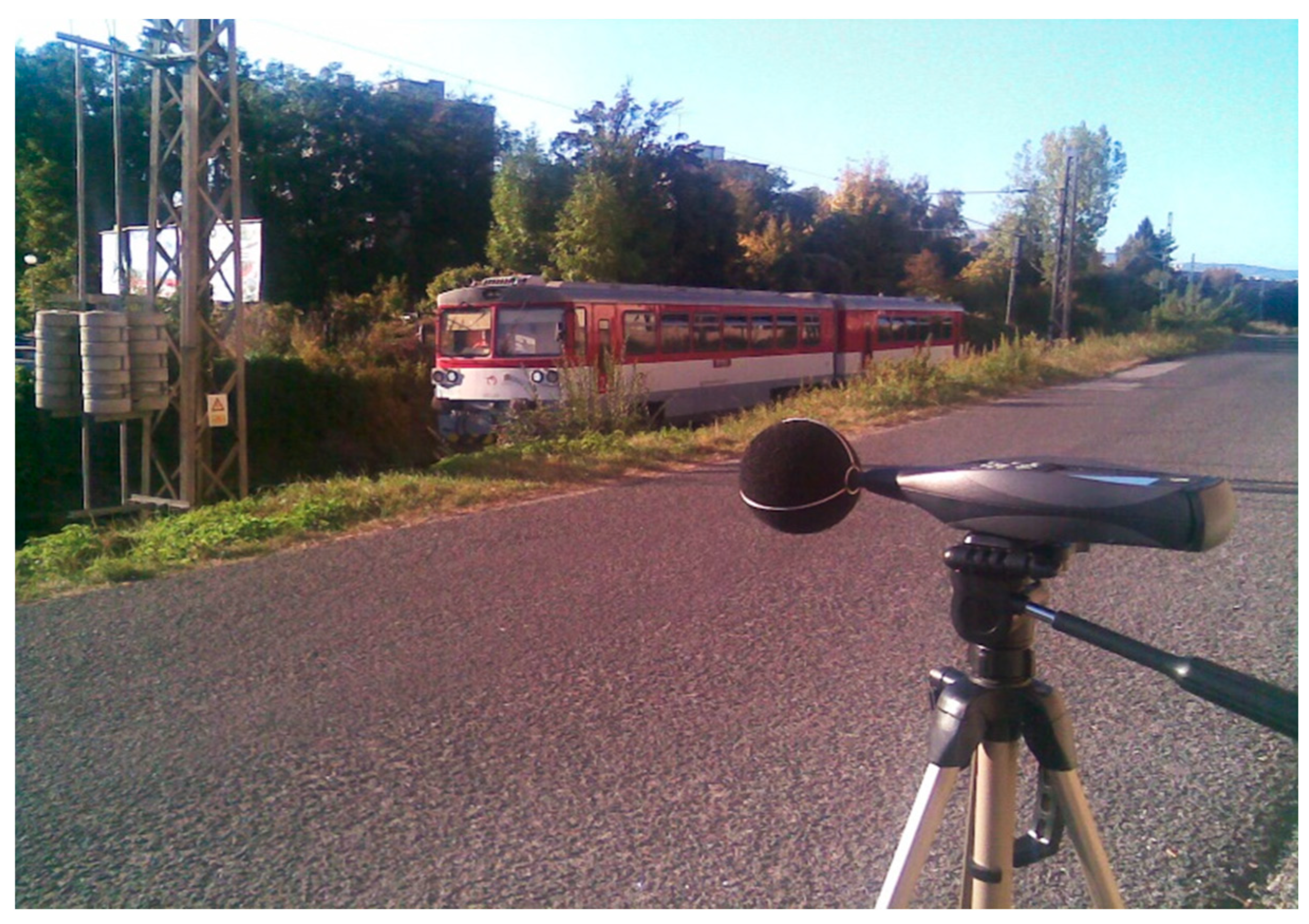
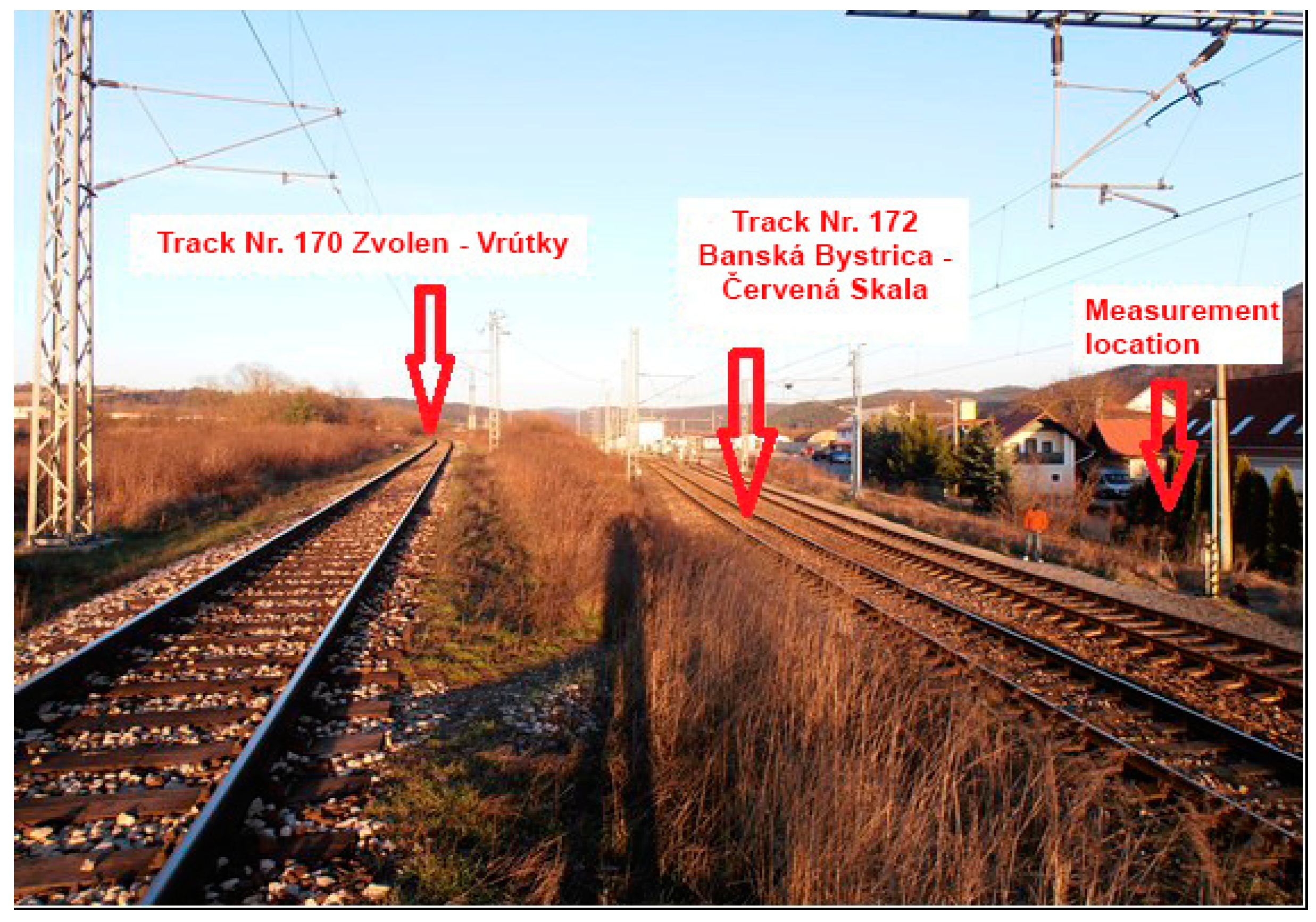
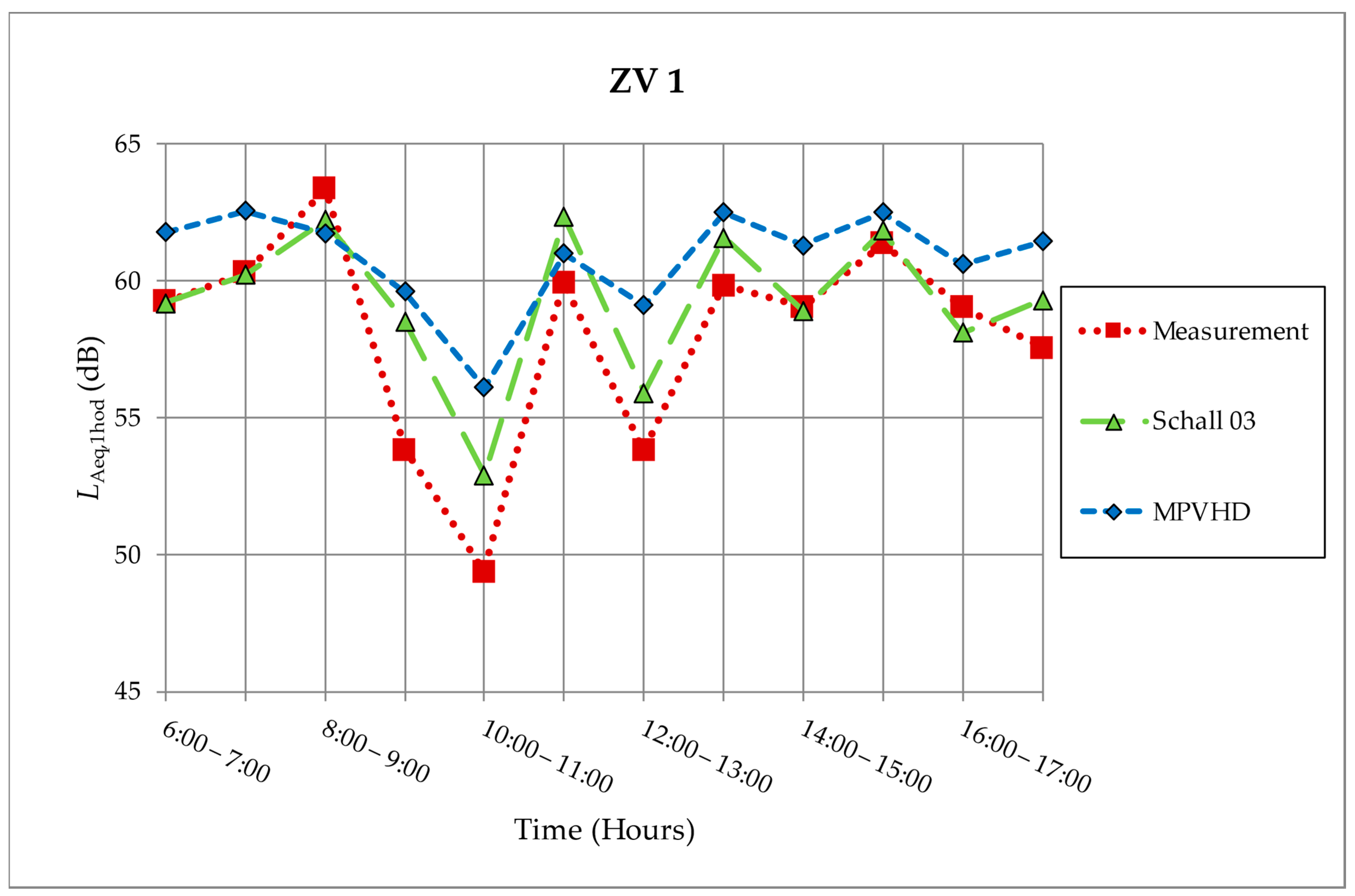

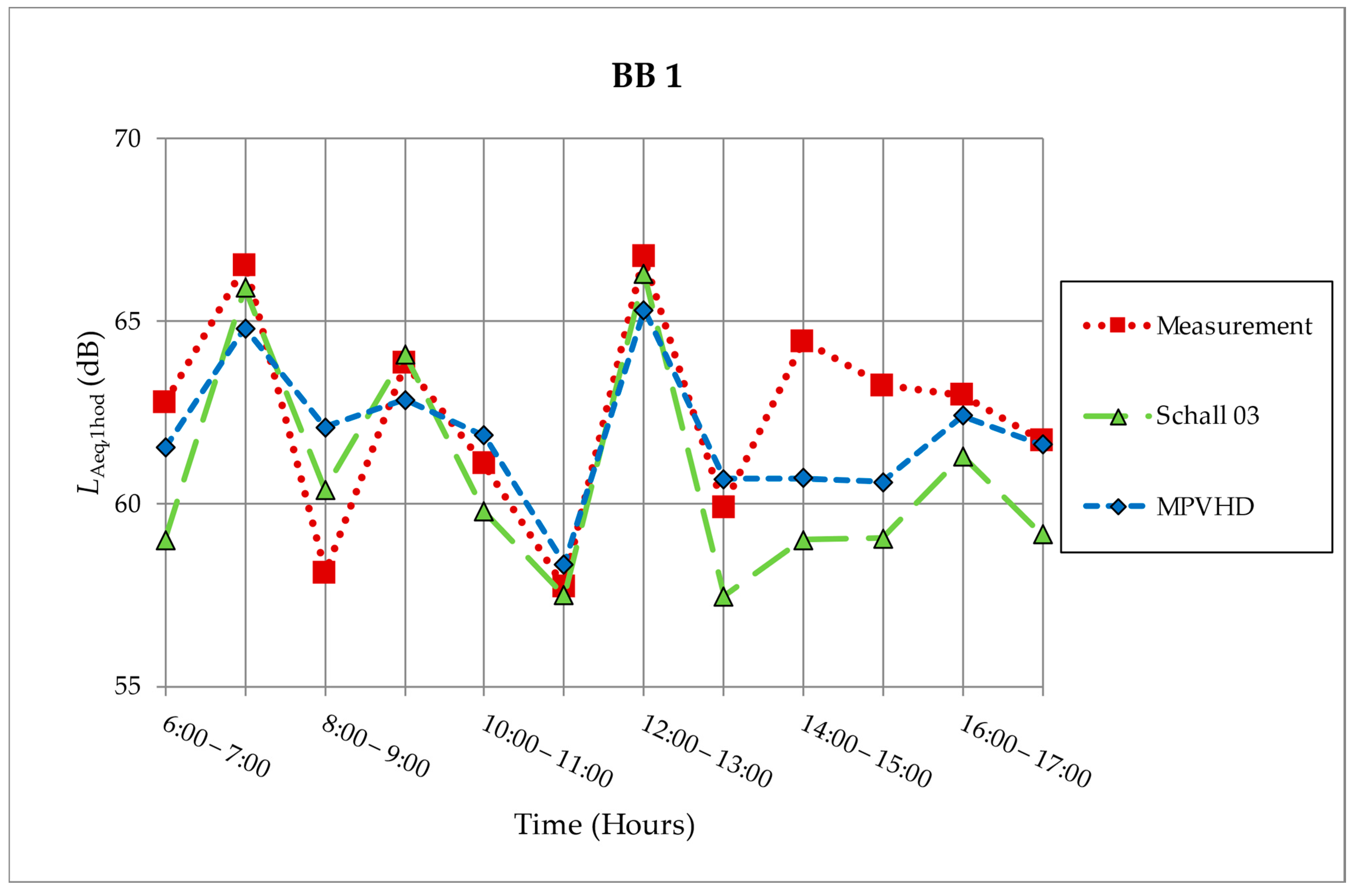

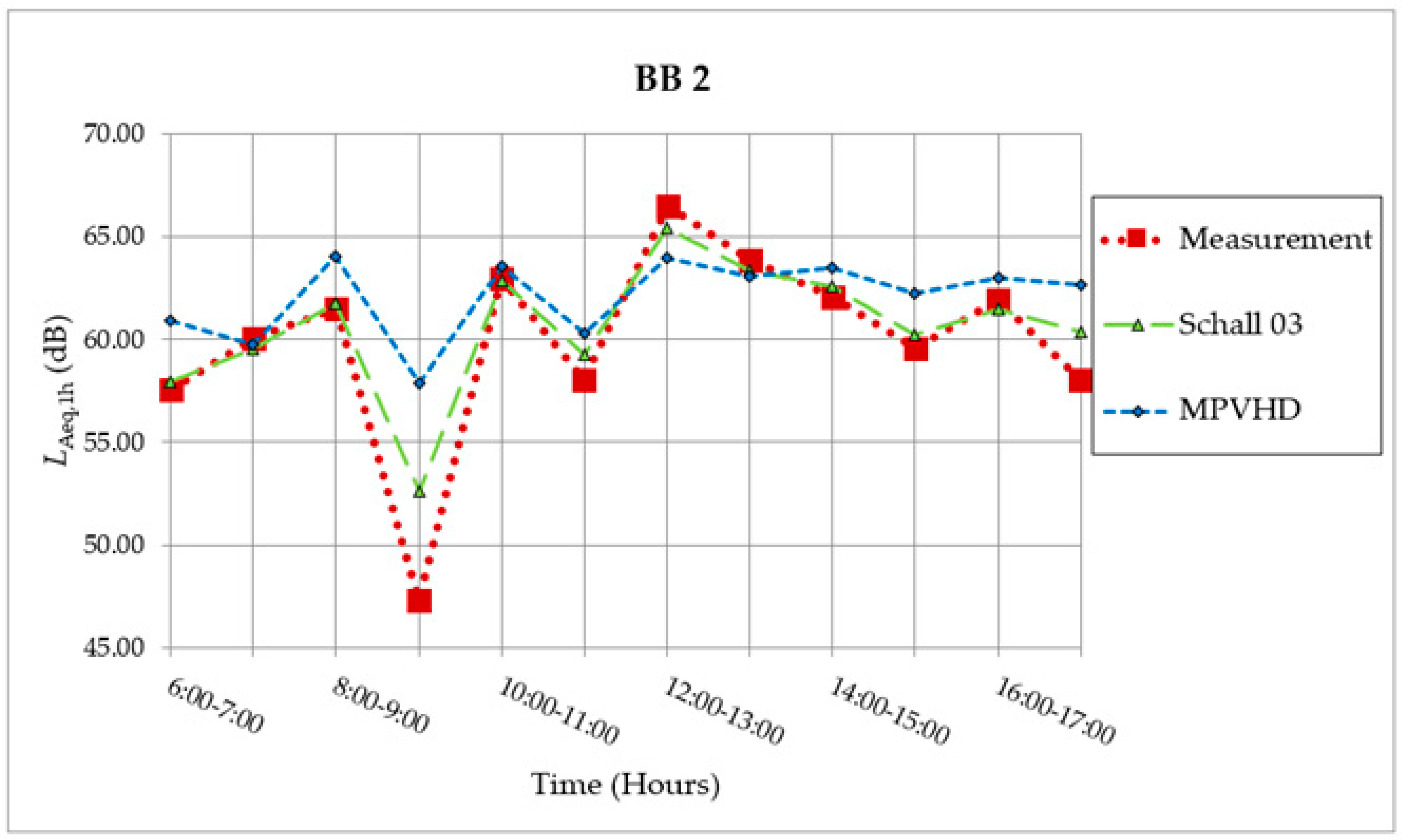
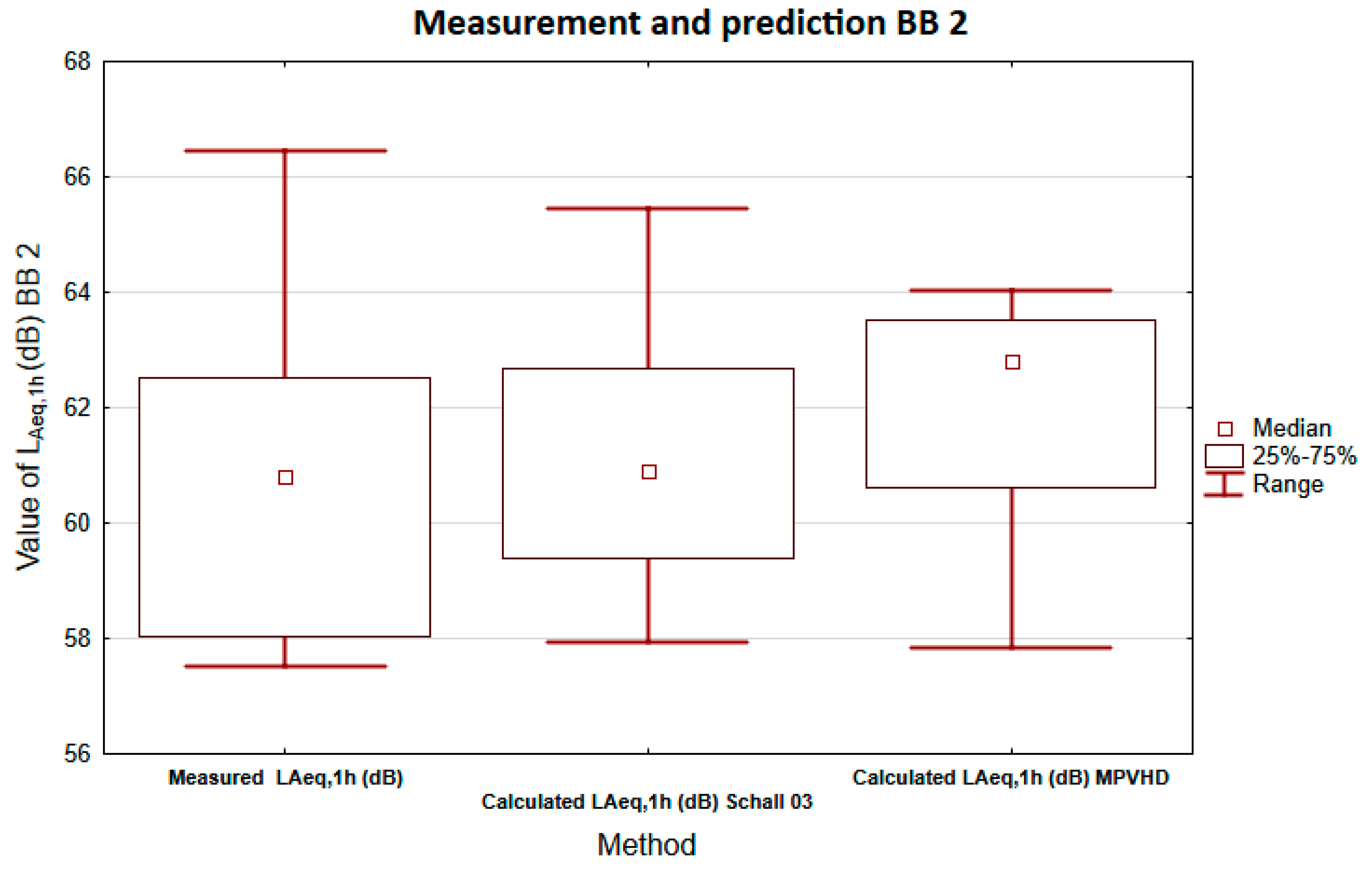
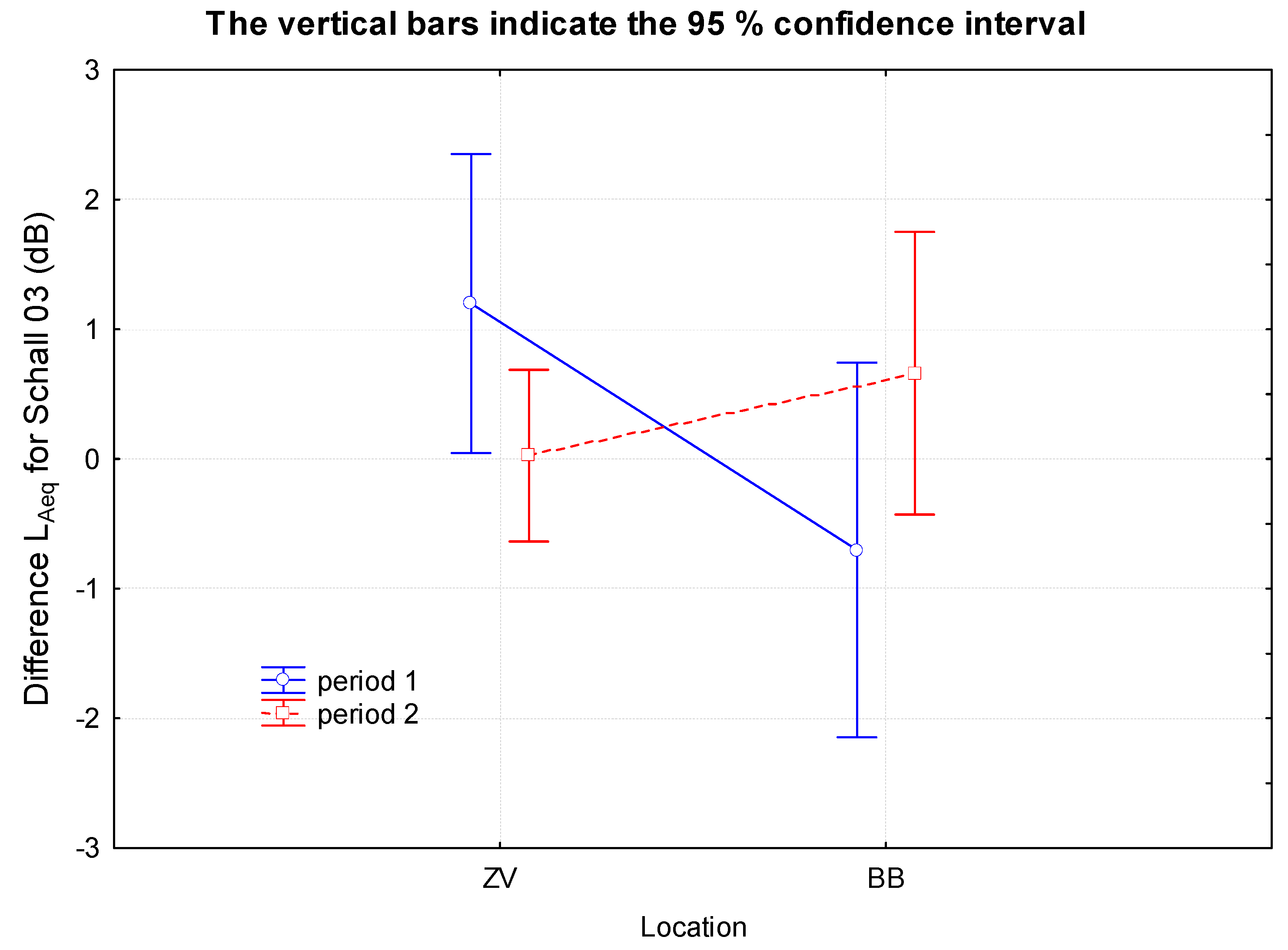

| Correction/Method | Schall 03 | MPVHD |
|---|---|---|
| Country | Germany | Czech Republic |
| Reference point (distance) | 25 m | 7.5 m |
| Basic relationship | ||
| Deceleration | +1.6 dB | |
| Length | ||
| Speed | ||
| Type of track | Yes | No |
| Traction | No | engine F4 = 1.0 electric F4 = 0.65 |
| Direction Banská Bystrica-Červená Skala | Direction Červená Skala-Banská Bystrica | Direction Banská Bystrica-Vrútky | Direction Vrútky-Banská Bystrica | ||||
|---|---|---|---|---|---|---|---|
| Type | Number | Type | Number | Type | Number | Type | Number |
| Os | 9 | Os | 10 | Os | 0 | Os | 1 |
| Zr | 0 | Zr | 0 | Zr | 6 | Zr | 6 |
| R | 1 | R | 0 | R | 0 | R | 0 |
| N | 2 | N | 1 | N | 1 | N | 1 |
| Vú | 1 | Vú | 1 | Vú | 0 | Vú | 0 |
| Total | 13 | Total | 12 | Total | 7 | Total | 8 |
| Direction Banská Bystrica-Červená Skala | Direction Červená Skala-Banská Bystrica | Direction Banská Bystrica-Vrútky | Direction Vrútky-Banská Bystrica | ||||
|---|---|---|---|---|---|---|---|
| Type | Number | Type | Number | Type | Number | Type | Number |
| Os | 11 | Os | 9 | Os | 7 | Os | 7 |
| Zr | 0 | Zr | 0 | Zr | 0 | Zr | 0 |
| R | 0 | R | 0 | R | 0 | R | 0 |
| N | 1 | N | 1 | N | 1 | N | 1 |
| Vú | 0 | Vú | 0 | Vú | 0 | Vú | 1 |
| Total | 12 | Total | 10 | Total | 8 | Total | 9 |
| Efect | Sum of Squares | Degree of Freedom | Mean Squares | F-Test | p-Level |
|---|---|---|---|---|---|
| Abs. term | 0.11 | 1 | 0.11 | 0.03 | 0.846 |
| location | 15.25 | 1 | 15.25 | 5.12 | 0.029 |
| period | 4.16 | 1 | 4.16 | 1.40 | 0.243 |
| location*period | 37.27 | 1 | 37.27 | 12.51 | 0.001 |
| Error | 131.11 | 44 | 2.97 |
| Efect | Sum of Squares | Degree of Freedom | Mean Squares | F-Test | p-Level |
|---|---|---|---|---|---|
| Abs. term | 105.70 | 1 | 105.70 | 17.65 | 0.000 |
| Location | 23.14 | 1 | 23.14 | 3.86 | 0.056 |
| Period | 5.915 | 1 | 5.91 | 0.99 | 0.326 |
| location*period | 45.49 | 1 | 45.49 | 7.60 | 0.008 |
| Error | 263.49 | 44 | 5.98 |
| Location | MPVHD | Schall 03 |
|---|---|---|
| ZV1 * | +1.3 dB | +0.6 dB |
| ZV2 * | +0.9 dB | −0.3 dB |
| BB1 | −1.0 dB | −1.4 dB |
| BB2 | +0.8 dB | −0.1 dB |
Publisher’s Note: MDPI stays neutral with regard to jurisdictional claims in published maps and institutional affiliations. |
© 2021 by the authors. Licensee MDPI, Basel, Switzerland. This article is an open access article distributed under the terms and conditions of the Creative Commons Attribution (CC BY) license (https://creativecommons.org/licenses/by/4.0/).
Share and Cite
Němec, M.; Gergeľ, T.; Gejdoš, M.; Danihelová, A.; Ondrejka, V. Selected Approaches to the Assessment of Environmental Noise from Railways in Urban Areas. Int. J. Environ. Res. Public Health 2021, 18, 7086. https://doi.org/10.3390/ijerph18137086
Němec M, Gergeľ T, Gejdoš M, Danihelová A, Ondrejka V. Selected Approaches to the Assessment of Environmental Noise from Railways in Urban Areas. International Journal of Environmental Research and Public Health. 2021; 18(13):7086. https://doi.org/10.3390/ijerph18137086
Chicago/Turabian StyleNěmec, Miroslav, Tomáš Gergeľ, Miloš Gejdoš, Anna Danihelová, and Vojtěch Ondrejka. 2021. "Selected Approaches to the Assessment of Environmental Noise from Railways in Urban Areas" International Journal of Environmental Research and Public Health 18, no. 13: 7086. https://doi.org/10.3390/ijerph18137086
APA StyleNěmec, M., Gergeľ, T., Gejdoš, M., Danihelová, A., & Ondrejka, V. (2021). Selected Approaches to the Assessment of Environmental Noise from Railways in Urban Areas. International Journal of Environmental Research and Public Health, 18(13), 7086. https://doi.org/10.3390/ijerph18137086









